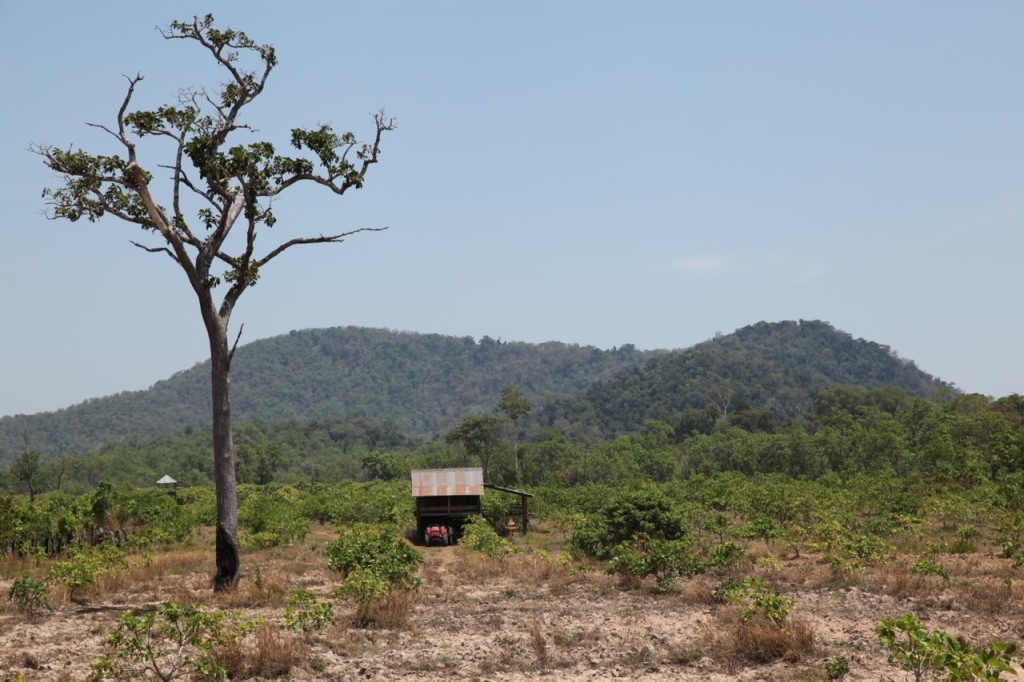ឧស្សាហកម្មនិស្សារណកម្មនៅកម្ពុជា ធ្វើតាមបែបប្រពៃណីក្រោម ទ្រង់ទ្រាយជាពាណិជ្ជកម្មខ្នាតតូច ដែលភាគច្រើនជាការរុករកវត្ថុធាតុដើមសម្រាប់សាងសង់ មាស និងត្បូង។ ខណៈដែលការរុករករ៉ែ ប្រេង និងឧស្ម័ន កំពុងត្រូវបានគ្រប់គ្រងដោយបទបញ្ជាជាធរមាន ច្បាប់ថ្មីគ្រប់គ្រងការរុករកទាញយកប្រេង និងរ៉ែ កំពុងត្រូវបានធ្វើឡើង។

អ្នកស្រុកនៅខេត្តកំពង់ចាមស្គាល់ភ្នំនេះថាជា ភ្នំដែក។ រ៉ែដែកត្រូវបានរកឃើញនៅទីនេះ។ រូបភាព ថតដោយក្រុមការងារអង្គការទិន្នន័យអំពីការអភិវឌ្ឍ នៅថ្ងៃទី៨ ខែកក្កដា ឆ្នាំ២០១៥ ។ ក្រោមអាជ្ញាប័ណ្ណ៖ CC-BY-NC-ND 2.0
នៅក្នុងវិស័យរុករករ៉ែ ក្រុមហ៊ុនទាំងអស់ ត្រូវចុះបញ្ជីជាមួយក្រសួង រ៉ែ និងថាមពល មុនចាប់ដំណើរការការងាររុករករ៉ែ ហើយសមត្ថភាពបច្ចេកទេស និងហិរញ្ញវត្ថុរបស់ក្រុមហ៊ុន ក៏នឹងត្រូវបានវាយតម្លៃផង ដែរ។
នៅត្រឹមថ្ងៃទី ៣០ ខែវិច្ឆិកា ឆ្នាំ២០១៣ ក្រុមហ៊ុនរុករករ៉ែជាតិនិងអន្តរជាតិ ចំនួន ១០៦ ក្រុមហ៊ុន បានកំពុងប្រតិបត្តិការនៅក្នុងប្រទេស កម្ពុជា។ ១៣២ អាជ្ញាប័ណ្ណ ត្រូវបានផ្តល់ឱ្យសម្រាប់លោហធាតុ ២ អាជ្ញាប័ណ្ណសម្រាប់បុកស៊ីត ២អាជ្ញាប័ណ្ណសម្រាប់ខ្សាច់ស៊ីលីកា និង ១១ អាជ្ញាប័ណ្ណសម្រាប់ធ្យូងថ្ម។ ស្របពេលជាមួយគ្នានេះ អាជ្ញាប័ណ្ណ ចំនួន ១៤ ត្រូវបានផ្តល់ឱ្យសម្រាប់ការជីករ៉ែ ក្នុងនោះ ៤ អាជ្ញាប័ណ្ណ សម្រាប់រ៉ែមាស ១អាជ្ញាប័ណ្ណសម្រាប់រ៉ែដែក ១អាជ្ញាប័ណ្ណសម្រាប់ការជីកយកត្បូង និង ៧អាជ្ញាប័ណ្ណសម្រាប់ការជីករ៉ែថ្មកំបោរ (សម្រាប់ផលិតស៊ីម៉ងត៍) និង ១អាជ្ញាប័ណ្ណសម្រាប់ផូស្វាត។1 នៅខែកក្កដាឆ្នាំ ២០១៥ នេះក្រសួងរ៉ែ និងថាមពលបានផ្តល់អាជ្ញាប័ណ្ណចំនួន ៤ ឱ្យទៅក្រុមហ៊ុនសំណង់ជីនលីង ក្រុមហ៊ុនសាជីវកម្ម ខ្មែរ អនុសា ខូអិលធីឌី និងក្រុមហ៊ុន តាំង គីមអេង ខូអិលធីឌី សម្រាប់ការបូមខ្សាច់នៅតាមដងទន្លេមេគង្គ។2
អាជ្ញាប័ណ្ណរ៉ែ
អាជ្ញាប័ណ្ណរ៉ែ ចែកជា៦ប្រភេទផ្សេងៗគ្នារួមមាន៖
- អាជ្ញាប័ណ្ណរុករករ៉ែជាលក្ខណៈសិប្បកម្ម៖ មានតែប្រជាពលរដ្ឋខ្មែរប៉ុណ្ណោះដែលមានសិទ្ធិដាក់ពាក្យស្នើសុំអាជ្ញាប័ណ្ណប្រភេទនេះ។ បុគ្គលដែលដាក់ពាក្យសុំ ត្រូវប្រើប្រាស់ឧបករណ៍ហត្ថកម្មក្នុងស្រុក និងធ្វើ ប្រតិបត្តិការក្នុងជាលក្ខណៈអាជីវកម្មគ្រួសារ ដោយសមាជិកមិនលើសពី៧នាក់ ។
- អាជ្ញាប័ណ្ណខូង និង រូងយករ៉ែ៖ សកម្មភាពដែលអនុញាតិ្តរួមមានការរុករករ៉ែសម្រាប់សម្ភារសំណង់ និងសារធាតុឧស្សាហកម្ម រូងយកពីរណ្តៅ និងប្រើសម្រាប់ការសាងសង់ ព្រមទាំង គីមីនិងឧស្សាហកម្មកែច្នៃ។
- អាជ្ញាប័ណ្ណរុករករ៉ែត្បូង៖ សម្រាប់ការទាញយកត្បូងថ្មមានតម្លៃ ពាក់កណ្តាលមានតម្លៃ និងថ្មសម្រាប់តុបតែងលម្អ ។
- អាជ្ញាប័ណ្ណកែច្នៃធនធានរ៉ែត្បូង៖ សម្រាប់ការកាត់យកត្បូងថ្មមានតម្លៃ ពាក់កណ្តាលមានតម្លៃនិងថ្មសម្រាប់តុបតែងលម្អ។
- អាជ្ញាប័ណ្ណរុករករ៉ែ៖ សម្រាប់ការរុករកធនធានរ៉ែ។
- អាជ្ញាប័ណ្ណរុករកជាឧស្សាហកម្ម៖ មានតែសម្បទានិក ដែលកាន់កាប់អាជ្ញាប័ណ្ណរុករករ៉ែតែប៉ុណ្ណោះ ទើបមានសិទ្ធិដាក់ពាក្យស្នើសុំអាជ្ញាប័ណ្ណប្រភេទនេះ។
ក្រុមហ៊ុនទាំងឡាយ ដែលមានអាជ្ញាប័ណ្ណរករករ៉ែ ត្រូវឆ្លងកាត់ការ វាយតម្លៃខាងបច្ចេកទេស ហិរញ្ញវត្ថុ បរិស្ថាន សង្គម និងសេដ្ឋកិច្ច មុន នឹងត្រូវអនុញ្ញាតឱ្យធ្វើការរុករករ៉ែ។3
បន្ទាប់ពីដាក់ទម្រង់បែបបទពេញលេញ សម្រាប់អាជ្ញាប័ណ្ណរុករករ៉ែ ក្រុមហ៊ុនស្នើសុំ នឹងទទួលបានការឆ្លើយតបពីក្រសួងឧស្សាហកម្ម រ៉ែនិងថាមពល ក្នុងរយៈពេល ៤៥ ថ្ងៃ។ សម្រាប់អាជ្ញាប័ណ្ណរុករករ៉ែជាលក្ខណៈសិប្បកម្ម បុគ្គល ឬអង្គភាព មានសិទ្ធិស្នើសុំបន្តអាណត្តិ ធ្វើវិសោធនកម្ម និងដាក់បញ្ចាំ ផ្ទេរសិទ្ធិ ឬផ្ទេរមរតក ជាមួយនឹងការព្រម ព្រៀងជាលាយលក្ខណ៍អក្សរពីរដ្ឋមន្ត្រីទទួលបន្ទុកលើវិស័យរ៉ែ។4
ការកែប្រែច្បាប់គ្រប់គ្រងការរុករករ៉ែ កំពុងស្ថិតនៅក្នុងគម្រោង។ មានការស្នើសំុសំដៅនាំមកនូវច្បាប់ថ្មីយកលំនាំតាមច្បាប់ស្តីពីការរុករករ៉ែរបស់ប្រទេសអូស្ត្រាលីភាគខាងលិច ដែលនឹងត្រូវជំនួស ប្រព័ន្ធកិច្ចសន្យានៅពេលបច្ចុប្បន្ន សម្រាប់ការទទួលបានអាជ្ញាប័ណ្ណរ៉ែ ជាមួយប្រព័ន្ធសម្បទាន ដែលផ្តល់សិទ្ធិដូចគ្នាចំពោះ ក្រុមហ៊ុនទាំងអស់ ដែលកំពុងរុករករ៉ែ នៅក្នុងប្រទេសកម្ពុជា។5
ប្រេង និងឧស្ម័ន
នៅក្នុងវិស័យធនធានរ៉ែ រដ្ឋធម្មនុញ្ញ ប្បញ្ញត្តិថា ប្រេង និងឧស្ម័នជាទ្រព្យសម្បត្តិរបស់រដ្ឋ។6 វិស័យនេះ ត្រូវបានគ្រប់គ្រងដោយបទប្បញ្ញត្តិប្រេងកាតដែលត្រូវបានធ្វើវិសោធនកម្ម នៅឆ្នាំ ១៩៩១។ នៅឆ្នាំ១៩៩៨ រដ្ឋាភិបាលបានបង្កើត អាជ្ញាធរប្រេងកាតជាតិកម្ពុជា នៅក្រោមក្រសួងឧស្សាហកម្ម រ៉ែ និងថាមពល (បច្ចុប្បន្ន ជាក្រសួងរ៉ែ និងថាមពល) ដើម្បីគ្រប់គ្រងធនធានប្រេងកាត។ អាជ្ញាធរប្រេងកាតទទួលបន្ទុកលើការវាយតម្លៃការដេញថ្លៃ និងផ្តល់អនុសាសន៍ដល់រាជរដ្ឋាភិបាលទៅលើការផ្តល់កិច្ចព្រមព្រៀងប្រេងកាតទៅក្រុមហ៊ុនជាក់លាក់។7
បទប្បញ្ញត្តិបានកំណត់ស្តង់ដារផ្សេងៗសម្រាប់សុវត្ថិភាពនិងសន្តិសុខ និងមានតម្រូវឱ្យក្រុមហ៊ុនចុះកិច្ចសន្យាការពារបរិស្ថានក្នុងស្រុក។8 ការវាយតម្លៃផលប៉ះពាល់បរិស្ថានពេញលេញ ជាលក្ខខណ្ឌតម្រូវចាំបាច់សម្រាប់រាល់ប្រតិបត្តិការលើប្រេងនិងឧស្ម័ន។9
នាពេលបច្ចុប្បន្ន ច្បាប់ថ្មី សម្រាប់គ្រប់គ្រងលើការរុករក និងទាញយកប្រេង កំពុងត្រូវរៀបចំឡើង។
ធ្វើបច្ចុប្បន្នភាពចុងក្រោយ ថ្ងៃទី១៨ ខែមករា ឆ្នាំ២០១៦
ឯកសារយោង
- 1. អគ្គនាយកដ្ឋានធនធានរ៉ែ.ក្រសួងរ៉ែនិងថាមពល.២០១៤. http://www.mme.gov.kh/administrator/gd-link-page.php?gd1=925
- 2. អ៊ួច សូនី. “ក្រសួងផ្តល់អាជ្ញាប័ណ្ណបូមខ្សាច់ ដល់ក្រុមហ៊ុនចំនួនបី.” ភ្នំពេញប៉ុស្តិ៍. ២៤ កក្កដា ឆ្នាំ២០១៥.https://www.cambodiadaily.com/news/ministry-awards-sand-dredging-lots-to-3-firms-89313/
- 3. ជ្រា វិចិត្រ. ឆ្នាំ២០១៣. “ស្ថានភាពបច្ចុប្បន្ននៃឧស្សាហកម្មរ៉ែនៅកម្ពុជា.” ក្រសួងឧស្សាហកម្មរ៉ែនិងថាមពល. http://mric.jogmec.go.jp/public/kouenkai/2013-03/briefing_130315_02a.pdf
- 4. ដូចយោងខាងដើម។
- 5. ក្រុមហ៊ុន អង្គរ ហ្គូល. ឆ្នាំ២០១៥. ចូលអាននៅថ្ងៃទី ២៥ ខែតុលា ឆ្នាំ២០១៥. http://angkorgold.ca/wp-content/uploads/2015/08/121-Group-Presentation.pdf/ ។
- 6. រដ្ឋធម្មនុញ្ញនៃព្រះរាជាណាចក្រកម្ពុជា,មាត្រា ៥៨
- 7. សេចក្តីសម្រេចលេខ ៧៣ ស្តីពីវិសោធនកម្មជំពូក ២ នៃបទបញ្ជាប្រេងកាត ឆ្នាំ១៩៩១ (ថ្ងៃទី១៨ ខែតុលា ឆ្នាំ១៩៩៨) និងសេចក្ដីសំរេចលេខ ២៥ ស្តីពីវិសោធនកម្ម នៃបទបញ្ជាប្រេងកាតឆ្នាំ ១៩៩១ (ថ្ងៃទី១៩ ខែ មីនា ឆ្នាំ១៩៩៩) នេះ។
- 8. បទប្បញ្ញត្តិប្រេងកាតឆ្នាំ១៩៩១, មាត្រា ២៥។
- 9. អនុក្រឹត្យស្តីអំពីដំណើរការវាយតម្លៃផលប៉ះពាល់បរិស្ថានឆ្នាំ ១៩៩៩ (ឧបសម្ព័ន្ធ)។

